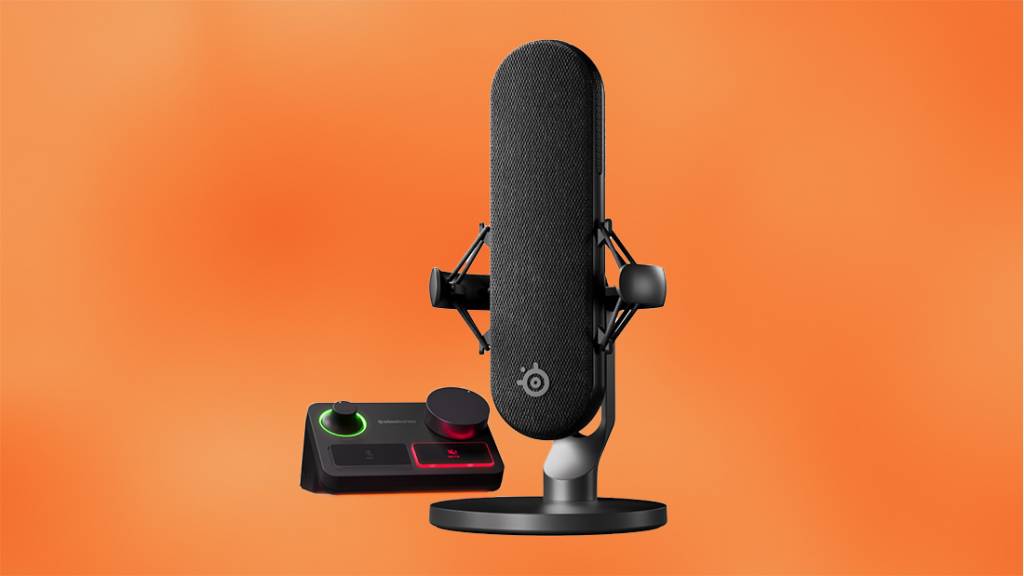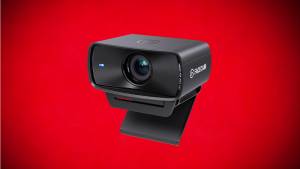SteelSeries Alias Pro XLR Streaming Microphone

design
The SteelSeries microphone duo are a bit like identical twins, at a quick glance it can be hard to tell them apart but if you look closely there are little giveaways that tell you which Alias is which. The SteelSeries Alias Pro is the simpler of the two microphone brothers and about as simple as you can get in terms of design. The Alias Pro keeps the same overall size, shape and design as the SteelSeries Alias – a flat faced tube without a sharp edge in sight. It’s a design language carried over from the Arena 7 Speakers, SteelSeries loves a rounded corner. The Pro is actually rather stripped back compared to the non-pro Alias, there’s no buttons, dials or lighting effects on this model – it’s the less outgoing twin.
Both Alias microphones are nicely put together with near black colour scheme across an upholstered front face and rounded plastic rear shell. This is an area of disappointment for me, albeit a minor one that I’ll quickly get over. Should a ‘Pro’ model still be all plastic and made of the same material as an option half its price? The plastic doesn’t feel or look cheap but for me should probably have been replaced with even the thinnest of metal shells instead. It’s little things like that that make a great first impression and can really ooze ‘Pro’.
Like the USB Alias there’s a pleasantly designed stand and shock mount included with the Alias Pro and while again it’s exactly the same as what comes in the cheaper model, I have no complains this time around. It’s already suitably high quality in build and performance, it confidently held the SteelSeries Alias Pro in place even while I fiddled about with the mic and cable. Annoying the same stand means the same issue I had when looking at the SteelSeries Alias – you’re limited to just a vertical orientation. It’s quite a tall microphone when it’s sat in the cradle and did cover parts of the bottom of my monitor, being able to turn this horizontally would offer a load of extra flexibility. To achieve this you’ll need to use the included adapter and mount the SteelSeries Alias Pro on a mic arm, I used the Elgato Wave Arm and it handled it just fine.

Apart from the switch of USB to XLR, the major difference with the SteelSeries Alias Pro over the base Alias is the included Stream Mixer, a combined audio interface and mini control centre. It’s quite a cute little companion that manages to achieve a lot in a box the size of a Stream Deck, the top houses two mute buttons and two dials – one controlling microphone gain and one that’s mappable in the SteelSeries Sonar app.
Each input is accompanied by RGB lighting with a bonus glowing LED bar on the bottom, just because. The button backlighting offers a visual cue to whether your mic is live or muted and the LED ring around the microphone gain dial dynamically reflects your input levels, jumping between green, yellow and red as your volume changes. While it’s cool at first glance and nice to have I didn’t find it anywhere near as useful as the hidden LED strip and cross on the body of the Alias, it’s too out of the way and I didn’t notice it most of the time.
Each button is large with a bit of rock to it but I found it responsive and never noticed any missed inputs as a result. The two dials are both differently shaped and sit far enough apart to have their own space and be easily differentiated at a glance. This is a good move by SteelSeries as mid-stream and mid-game I don’t want to be worried about whether I’m turning up my mic volume or game sound.
Across the back of the Stream Mixer you’ll find the all-important XLR input, phantom power indicator and dual USB-C connections, as well as a 3.5mm line out port and headphone monitoring jack. Those dual USB-C ports are a clever touch from SteelSeries as they allow creators running a dual-PC setup to send their audio to both at once. This can often be a major headache to configure and cause issues with AV sync so a single cable solution is a big win. The only problem is because of the Alias Stream Mixer’s compact size the two USB-C ports are pretty tightly tucked in under the XLR cable so I often had to unplug the XLR cable to make USB-C tweaks.

A special mention too for SteelSeries including everything you need to get going in the box with the Alias Pro. There’s no optional extras or secondary purchases here as not only does the Pro include the stand, shock mount and Stream Mixer audio interface but there’s also an XLR cable and two USB-C to USB-A cables. It’s a damning reflection on the state of the tech industry that this is worthy of calling out for praise, but that’s where are in 2024.
performance
One of the real benefits of the SteelSeries Alias Pro, and ironically one that is something you’d more associate with beginner rather than professional tech is it’s essentially plug and play. Because everything you need is in the box already setup was incredibly simple, plug everything in and you’re away. I didn’t make it a race but I’d be confident you could go from sealed box to streaming in ten minutes.
When I spoke to SteelSeries about the new Alias range they were particularly proud of the fact the same one inch capsule features in both the Alias and Alias Pro. Realistically capsule that size is Pro level and probably beyond more than the base Alias needs, rather than it feeling underpowered in the Alias Pro. It shouldn’t be surprise therefore that the SteelSeries Alias Pro sounds excellent, by default.
Even before you dive into the SteelSeries GG Sonar app to fiddle with filters and engage EQ the Alias Pro delivers clear, full audio and I was impressed at how well my voice came across on stream. This is a condenser microphone so you won’t find that heavy studio vibe here, instead the Alias Pro has a natural profile that sounds more like you’re having a conversation in the room rather than listening to a studio session.

Again SteelSeries were proud to explain their condenser choice to me and they make a compelling argument for why this approach is the better one for gamers and streamers alike. A condenser microphone isn’t fussy, meaning it’ll happily pull in audio from a far larger pickup area in front of it. This means little change in audio quality and sound as you move around in front of it and a greater distance you can afford to be from the microphone itself. For animated streamers or those whose microphone etiquette is a little lacking it’s a nice safety net for quality. The downside to this is sometimes condenser microphones will sound roomy and distant as a result, it’s a trap the Audio-Technica AT2020USB-XP falls into but SteelSeries has avoided and my voice remained present and rich.
I try to test microphones ‘raw’ initially, seeing what their default state can produce before trying to elevate that with software and post processing. The SteelSeries Alias Pro was excellent in this way, just like its USB sibling. If you do want to dial things in though the SteelSeries Sonar app has plenty on offer. Most creators will do just fine with one of the included presets, but the click and drag interface is simple to use if you want to craft your own custom sound.
Sonar also includes ClearCast AI noise cancellation which even at lower intensity levels does an amazing job at filtering out unwanted distractions. This is one of the best noise cancellation solutions I’ve tested and it performed just as well as Nvidia Broadcast but without the hit to GPU usage. I found it was superb at identifying what I did and didn’t want coming through to my viewers and did away with keyboard clacking, fan noise and desk bumps while not impacting the quality of my vocals as a result. It’s seriously impressive stuff and the fact it’s an unassuming extra within Sonar is a quiet confidence I love from SteelSeries.
summed up
Like its identical twin, the SteelSeries Alias Pro is an excellent microphone for streamers. If you’re looking to start creating content or making the move from a USB microphone the Alias Pro has everything you need to get off to a very strong start.
Everything is included and pretty much everything is great. The studio-grade one inch condenser capsule delivers clean, natural vocal performance and the Stream Mixer has everything you need at your fingertips. While at first glance the $329.99/£319.99 price tag might seem a lot, this is everything you need and you’ll likely spend more to replicate the setup with individual parts.














